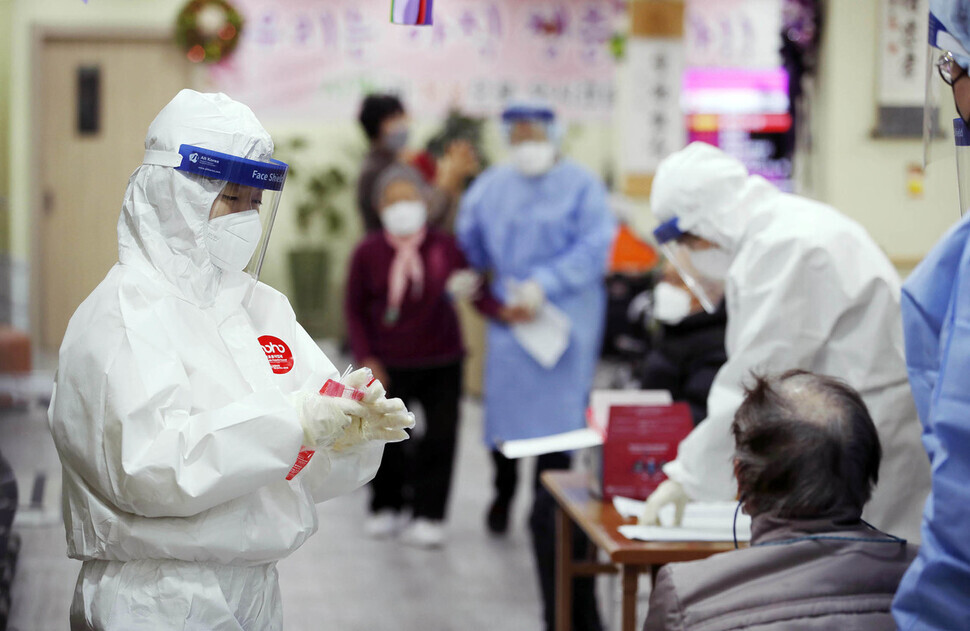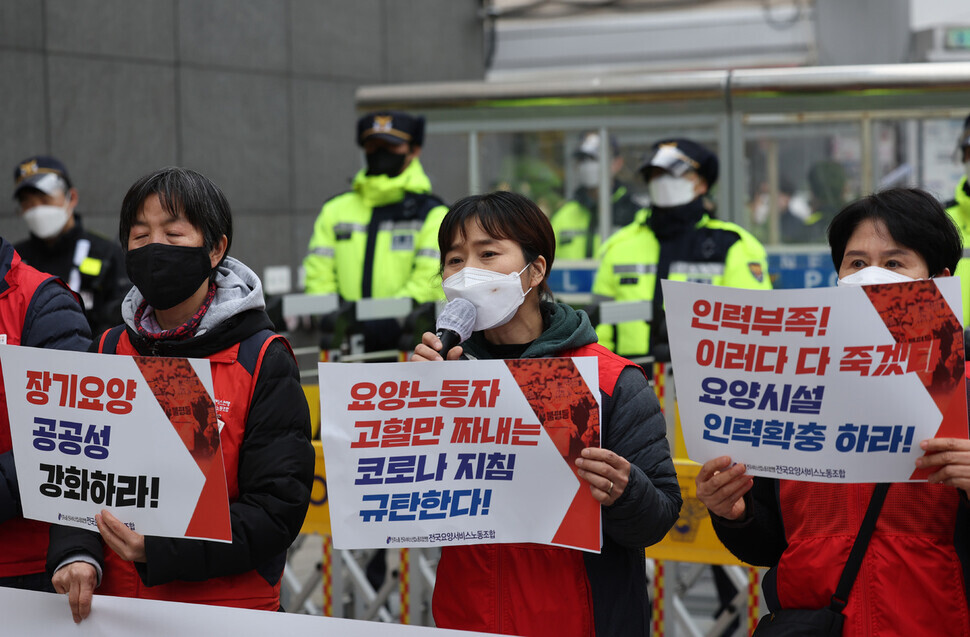hankyoreh
Links to other country sites 다른 나라 사이트 링크
Sick workers, lack of PPE puts S. Korean nursing facilities on brink of collapse

“Even if we tell them we have COVID-19 symptoms, they tell us to report to work anyway, saying, ‘No one else is available.’ Those who refuse to clock in end up getting fired. As a result, there’s an unending cycle of senior citizens and senior care workers getting diagnosed. Nursing facilities are just chaos right now.”
This was the assessment of a 54-year-old senior care worker surnamed Kim, who works at a senior care center in Incheon.
“These days, it isn’t at all unusual when the seniors at care facilities contract COVID-19,” Kim said. “Since so many of these seniors have underlying conditions, you even get the sense that they’re leaving it up to fate, saying, ‘Those who make it will make it, and those who don’t, won’t.”
“In the past, they would impose cohort isolation on senior care facilities when a [COVID-19] case was confirmed, but now senior care workers are basically exposed to Omicron when they care for seniors,” Kim added.
According to Korea Disease Control and Prevention Agency (KDCA) figures, patients at convalescent hospitals and senior care centers accounted for 647 of the 1,835 COVID-19 deaths recorded between March 11 and 17, or 35.3%.

The biggest problem is that mutual transmission of the virus between patients and workers at long-term care hospitals has become a routine occurrence.
A 54-year-old care worker surnamed Jeong at a Daegu senior care center self-tested for COVID-19 last month after being in contact with someone who tested positive. The result was negative, but Jeong had a temperature and told the center they wanted to take the day off.
“We’re short-staffed. You have to come in,” the center told them. Jeong reported to work and looked after patients; after returning home, they took another test.
This time the result was positive. Six of the seniors Jeong looked after that day were later diagnosed with COVID-19.
With the new daily caseload in South Korea hovering in the range of 300,000 for the past month or so, caregiving staff shortages have become a reality, which has led in turn to neglect in patient management.
“My mother-in-law suffered from terrible bedsores that she developed at a time when there were a lot of patients testing positive,” said a 46-year-old surnamed In whose mother-in-law is a patient at a long-term care hospital in Daejeon.
A 61-year-old care worker surnamed Kim in the same region said, “You can’t even bathe [patients] because of the infection risk.”
“You have to check whether they’re eating properly and on time and whether they have any complaints, but we’re all so exhausted that we’re just delivering their meals and then cleaning up afterward,” they added.
A 64-year-old care worker surnamed Lee said, “The situation is one where a single [worker] has to look after 17 to 30 seniors.”
“Ordinarily, I work from 7 am to 4 pm, but these days I’ve been working until 10 pm,” Lee added.
“It’s been so tough for us [workers] that some have talked about how they’d rather catch COVID-19.’”
A 49-year-old Incheon-area senior care worker surnamed Lee said, “Even when the seniors’ masks are dirty with phlegm, we aren’t changing them.”
“We’re supposed to change our protective gear from time to time too, but it’s so awkward to change out of it that some people just don’t wear it at all,” they added.
Lee also said, “The public health center doesn’t check in either. If you talk to the facility, they’ll tell you the government isn’t sending funds to pay for disease prevention equipment. They just say, ‘Buy it now and we’ll pay you back later.’”
“What care facility is going to purchase disease prevention equipment at its own expense?” they asked.
Kim Mi-sook heads the Daegu/North Gyeongsang chapter of the National Care Workers’ Union, which is affiliated with the Korean Federation of Service Workers’ Unions under the Korean Confederation of Trade Unions (KCTU).
“Early on in the COVID-19 [pandemic], the government would pay for disease prevention items and take responsibility for sterilization,” she explained. “Recently, we’ve reached the point where they’re just telling the facilities to take care of it themselves.”
Choi Hyeon-hye heads the Seoul municipal care center subcommittee of the healthcare solidarity headquarters within the KCTU’s Korean Public Service and Transport Workers’ Union.
“The structure of long-term care hospitals is such that they have no independent space for isolation [of COVID-19 patients], and it’s not possible for them to have dedicated staff for caring for patients who test positive,” she explained.
“It’s also pretty much impossible to send patients who’ve tested positive to the hospital,” she added. “We’ve had seniors who were taken away in an ambulance, only to return a few hours later because there weren’t any hospitals available to take them.”
“Imminent system collapse” for long-term care hospitalsWorkers on the ground are voicing fears of an imminent healthcare system collapse.
For two years after COVID-19 was first detected in South Korea, the Daegu Treatment Silver Hospital in southern Daegu’s Nam District had not had a single person test positive for the virus until Feb. 18, when one of the healthcare staff was diagnosed.
Early on, those who tested positive would be transported to a dedicated infectious disease hospital based on discussions with public health authorities. But with 76 positive cases to date, the hospital has been managing patients itself.
“Back when there were only a few positive cases, we would send them to a dedicated hospital to protect the other patients. But now things have passed beyond the threshold,” said the hospital’s director, Kim Hyeon-su.
“Now there are so many confirmed cases in the hospital that it would be pointless to transfer them to a dedicated hospital, and since the patients’ condition might end up even worse after going to a dedicated hospital, we’ve had no choice but to manage them ourselves,” Kim Hyeon-su added.
Noh Dong-hoon, director of the public relations committee for the Korean Convalescent Hospital Association, said, “Nursing staff are now working two to three times more than usual.”
“There’s such a severe shortage of workers that it’s tough to come up with a ‘manual,’” he explained.
“Right now, the healthcare system for convalescent hospitals is on the brink of collapse,” he warned.
Commenting on the recent cluster infections at convalescent hospitals and care facilities, Jacob Lee, a professor of infectious diseases at Hallym University Kangnam Sacred Heart Hospital, said, “When you don’t have relief staff for when care workers are infected, or when you start leaving patients in hospitals and centers after they test positive because there aren’t any beds left at the dedicated convalescent hospitals for infectious diseases, things only end up escalating.”
“Rather than forcing people together, we need to set up an alternative system now where they allow [patients] to live at home and look after them there,” he suggested.
By Kim Gyu-hyun, staff reporter; Choi Ye-rin, staff reporter; Lim Jae-hee, staff reporter; Park Soo-hyuk, staff reporter
Please direct questions or comments to [english@hani.co.kr]

Editorial・opinion
![[Editorial] Yoon must halt procurement of SM-3 interceptor missiles [Editorial] Yoon must halt procurement of SM-3 interceptor missiles](https://flexible.img.hani.co.kr/flexible/normal/500/300/imgdb/child/2024/0501/17145495551605_1717145495195344.jpg) [Editorial] Yoon must halt procurement of SM-3 interceptor missiles
[Editorial] Yoon must halt procurement of SM-3 interceptor missiles![[Guest essay] Maybe Korea’s rapid population decline is an opportunity, not a crisis [Guest essay] Maybe Korea’s rapid population decline is an opportunity, not a crisis](https://flexible.img.hani.co.kr/flexible/normal/500/300/imgdb/original/2024/0430/9417144634983596.jpg) [Guest essay] Maybe Korea’s rapid population decline is an opportunity, not a crisis
[Guest essay] Maybe Korea’s rapid population decline is an opportunity, not a crisis- [Column] Can Yoon steer diplomacy with Russia, China back on track?
- [Column] Season 2 of special prosecutor probe may be coming to Korea soon
- [Column] Park Geun-hye déjà vu in Yoon Suk-yeol
- [Editorial] New weight of N. Korea’s nuclear threats makes dialogue all the more urgent
- [Guest essay] The real reason Korea’s new right wants to dub Rhee a founding father
- [Column] ‘Choson’: Is it time we start referring to N. Korea in its own terms?
- [Editorial] Japan’s rewriting of history with Korea has gone too far
- [Column] The president’s questionable capacity for dialogue
Most viewed articles
- 1Months and months of overdue wages are pushing migrant workers in Korea into debt
- 2Trump asks why US would defend Korea, hints at hiking Seoul’s defense cost burden
- 3At heart of West’s handwringing over Chinese ‘overcapacity,’ a battle to lead key future industries
- 4[Editorial] Yoon must halt procurement of SM-3 interceptor missiles
- 5Fruitless Yoon-Lee summit inflames partisan tensions in Korea
- 61 in 3 S. Korean security experts support nuclear armament, CSIS finds
- 7Dermatology, plastic surgery drove record medical tourism to Korea in 2023
- 8AI is catching up with humans at a ‘shocking’ rate
- 9First meeting between Yoon, Lee in 2 years ends without compromise or agreement
- 10Amnesty notes ‘erosion’ of freedom of expression in Korea in annual human rights report